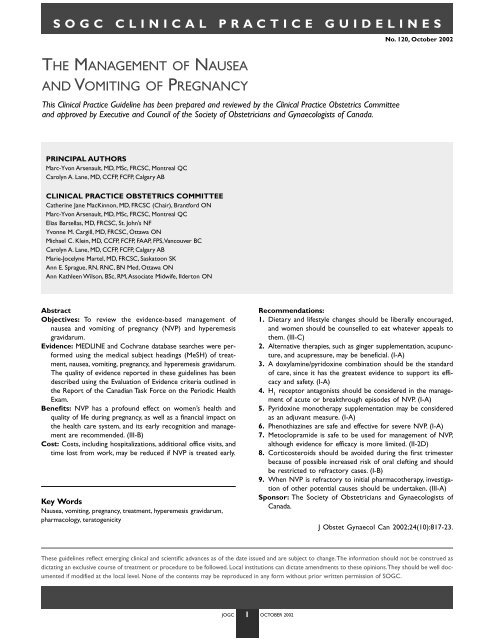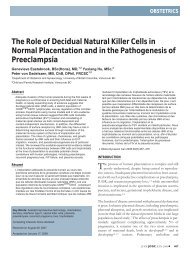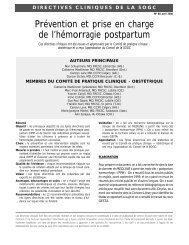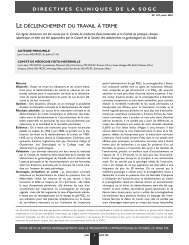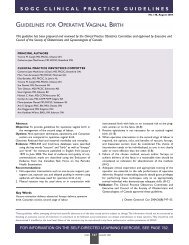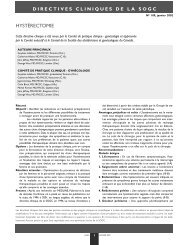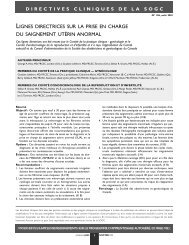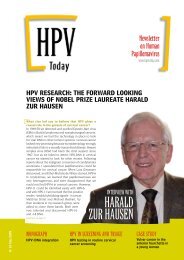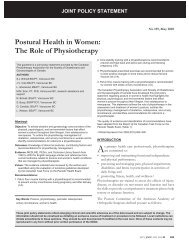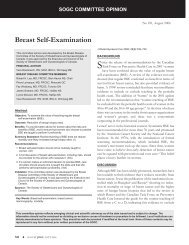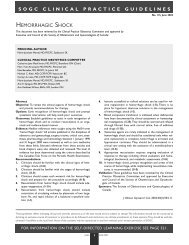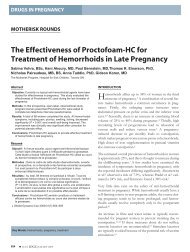The Management of Nausea - SOGC
The Management of Nausea - SOGC
The Management of Nausea - SOGC
You also want an ePaper? Increase the reach of your titles
YUMPU automatically turns print PDFs into web optimized ePapers that Google loves.
<strong>SOGC</strong> CLINICAL PRACTICE GUIDELINES<br />
THE MANAGEMENT OF NAUSEA<br />
AND VOMITING OF PREGNANCY<br />
This Clinical Practice Guideline has been prepared and reviewed by the Clinical Practice Obstetrics Committee<br />
and approved by Executive and Council <strong>of</strong> the Society <strong>of</strong> Obstetricians and Gynaecologists <strong>of</strong> Canada.<br />
PRINCIPAL AUTHORS<br />
Marc-Yvon Arsenault, MD, MSc, FRCSC, Montreal QC<br />
Carolyn A. Lane, MD, CCFP, FCFP, Calgary AB<br />
CLINICAL PRACTICE OBSTETRICS COMMITTEE<br />
Catherine Jane MacKinnon, MD, FRCSC (Chair), Brantford ON<br />
Marc-Yvon Arsenault, MD, MSc, FRCSC, Montreal QC<br />
Elias Bartellas, MD, FRCSC, St. John’s NF<br />
Yvonne M. Cargill, MD, FRCSC, Ottawa ON<br />
Michael C. Klein, MD, CCFP, FCFP, FAAP, FPS,Vancouver BC<br />
Carolyn A. Lane, MD, CCFP, FCFP, Calgary AB<br />
Marie-Jocelyne Martel, MD, FRCSC, Saskatoon SK<br />
Ann E. Sprague, RN, RNC, BN Med, Ottawa ON<br />
Ann Kathleen Wilson, BSc, RM,Associate Midwife, Ilderton ON<br />
Abstract<br />
Objectives: To review the evidence-based management <strong>of</strong><br />
nausea and vomiting <strong>of</strong> pregnancy (NVP) and hyperemesis<br />
gravidarum.<br />
Evidence: MEDLINE and Cochrane database searches were performed<br />
using the medical subject headings (MeSH) <strong>of</strong> treatment,<br />
nausea, vomiting, pregnancy, and hyperemesis gravidarum.<br />
<strong>The</strong> quality <strong>of</strong> evidence reported in these guidelines has been<br />
described using the Evaluation <strong>of</strong> Evidence criteria outlined in<br />
the Report <strong>of</strong> the Canadian Task Force on the Periodic Health<br />
Exam.<br />
Benefits: NVP has a pr<strong>of</strong>ound effect on women’s health and<br />
quality <strong>of</strong> life during pregnancy, as well as a financial impact on<br />
the health care system, and its early recognition and management<br />
are recommended. (III-B)<br />
Cost: Costs, including hospitalizations, additional <strong>of</strong>fice visits, and<br />
time lost from work, may be reduced if NVP is treated early.<br />
Key Words<br />
<strong>Nausea</strong>, vomiting, pregnancy, treatment, hyperemesis gravidarum,<br />
pharmacology, teratogenicity<br />
1<br />
Recommendations:<br />
1. Dietary and lifestyle changes should be liberally encouraged,<br />
and women should be counselled to eat whatever appeals to<br />
them. (III-C)<br />
2. Alternative therapies, such as ginger supplementation, acupuncture,<br />
and acupressure, may be beneficial. (I-A)<br />
3. A doxylamine/pyridoxine combination should be the standard<br />
<strong>of</strong> care, since it has the greatest evidence to support its efficacy<br />
and safety. (I-A)<br />
4. H 1 receptor antagonists should be considered in the management<br />
<strong>of</strong> acute or breakthrough episodes <strong>of</strong> NVP. (I-A)<br />
5. Pyridoxine monotherapy supplementation may be considered<br />
as an adjuvant measure. (I-A)<br />
6. Phenothiazines are safe and effective for severe NVP. (I-A)<br />
7. Metoclopramide is safe to be used for management <strong>of</strong> NVP,<br />
although evidence for efficacy is more limited. (II-2D)<br />
8. Corticosteroids should be avoided during the first trimester<br />
because <strong>of</strong> possible increased risk <strong>of</strong> oral clefting and should<br />
be restricted to refractory cases. (I-B)<br />
9. When NVP is refractory to initial pharmacotherapy, investigation<br />
<strong>of</strong> other potential causes should be undertaken. (III-A)<br />
Sponsor: <strong>The</strong> Society <strong>of</strong> Obstetricians and Gynaecologists <strong>of</strong><br />
Canada.<br />
JOGC OCTOBER 2002<br />
No. 120, October 2002<br />
J Obstet Gynaecol Can 2002;24(10):817-23.<br />
<strong>The</strong>se guidelines reflect emerging clinical and scientific advances as <strong>of</strong> the date issued and are subject to change.<strong>The</strong> information should not be construed as<br />
dictating an exclusive course <strong>of</strong> treatment or procedure to be followed. Local institutions can dictate amendments to these opinions.<strong>The</strong>y should be well documented<br />
if modified at the local level. None <strong>of</strong> the contents may be reproduced in any form without prior written permission <strong>of</strong> <strong>SOGC</strong>.
INTRODUCTION<br />
<strong>Nausea</strong> and vomiting <strong>of</strong> pregnancy (NVP) is the most common<br />
medical condition in pregnancy, affecting 50%–90% <strong>of</strong> women. 1<br />
<strong>The</strong> most severe form <strong>of</strong> NVP is commonly referred to as hyperemesis<br />
gravidarum (HG). HG, defined as persistent vomiting<br />
that leads to weight loss greater than 5% <strong>of</strong> pre-pregnancy weight,<br />
with associated electrolyte imbalance and ketonuria, 1 occurs in<br />
about 1% <strong>of</strong> pregnancies. 1 Although NVP may be classified as<br />
mild, moderate, or severe, the severity <strong>of</strong> nausea or vomiting may<br />
not adequately reflect the distress it causes.<br />
<strong>The</strong> physical and emotional impact <strong>of</strong> NVP <strong>of</strong>ten results<br />
in feelings <strong>of</strong> anxiety and worry about the effect <strong>of</strong> the symptoms<br />
on the fetus. It has a negative impact on family relationships<br />
and has major consequences on women’s working<br />
abilities; 47% <strong>of</strong> working women with NVP feel job efficiency<br />
is reduced, 3 35% lose work time (mean loss <strong>of</strong> 62 working<br />
hours per woman), 3 and 25% lose time from housework (mean<br />
loss <strong>of</strong> 32 hours per woman). 1-4 NVP is also cited as a reason<br />
for elective termination <strong>of</strong> pregnancy. 5 This is not surprising<br />
when it is recognized that nausea experienced by pregnant<br />
women with NVP (excluding HG patients) is comparable in<br />
severity to the nausea experienced by patients undergoing cancer<br />
chemotherapy. 6<br />
Each year, a significant number <strong>of</strong> women have one or<br />
more hospital admissions for NVP (as many as 14 hospitalizations/1000<br />
births). 7 <strong>The</strong>refore, early recognition and management<br />
<strong>of</strong> NVP could have a pr<strong>of</strong>ound effect on women’s<br />
health and quality <strong>of</strong> life during pregnancy, as well as a financial<br />
impact on the health care system.<br />
QUALITY OF EVIDENCE ASSESSMENT 8<br />
<strong>The</strong> quality <strong>of</strong> evidence reported in these guidelines has been<br />
described using the Evaluation <strong>of</strong> Evidence criteria outlined in<br />
the Report <strong>of</strong> the Canadian Task Force on the Periodic<br />
Health Exam.<br />
I: Evidence obtained from at least one properly randomized<br />
controlled trial.<br />
II-1: Evidence from well-designed controlled trials without<br />
randomization.<br />
II-2: Evidence from well-designed cohort (prospective or<br />
retrospective) or case-control studies, preferably from<br />
more than one centre or research group.<br />
II-3: Evidence obtained from comparisons between times or<br />
places with or without the intervention. Dramatic<br />
results in uncontrolled experiments (such as the results<br />
<strong>of</strong> treatment with penicillin in the 1940s) could also be<br />
included in this category.<br />
III: Opinions <strong>of</strong> respected authorities, based on clinical<br />
experience, descriptive studies, or reports <strong>of</strong> expert<br />
committees.<br />
1<br />
<strong>The</strong> pathogenesis <strong>of</strong> NVP is poorly understood and the<br />
etiology is likely to be multifactorial. Other causes <strong>of</strong> nausea<br />
and vomiting must be ruled out, including gastrointestinal,<br />
genitourinary, central nervous system, and toxic/metabolic<br />
problems. Idiopathic NVP must be distinguished from NVP<br />
<strong>of</strong> known etiology, such as hydatidiform mole or multiple gestation.<br />
In the aftermath <strong>of</strong> thalidomide and the voluntary withdrawal<br />
<strong>of</strong> Bendectin ® , pharmacological antiemetic therapy is<br />
still used with great caution by some patients and health care<br />
providers to treat NVP, and is erroneously considered to be<br />
contraindicated in pregnancy. 2 Care providers play a major role<br />
in counselling and reassuring patients on safe and effective<br />
treatments available for NVP. 2<br />
This document aims to provide an evidence-based guideline<br />
to treat NVP. Early treatment with counselling is preferable,<br />
after appropriate history-taking and physical examinations<br />
have been done. Recognizing and treating NVP in a timely<br />
fashion will prevent the progression <strong>of</strong> NVP to HG and maternal<br />
complications, and reduce the risk <strong>of</strong> parenteral therapy<br />
and HG-related costs, including hospitalizations, additional<br />
<strong>of</strong>fice visits, and time lost from work. This should eventually<br />
result in improved maternal health and quality <strong>of</strong> life, as well<br />
as better family relationships.<br />
<strong>The</strong> quality <strong>of</strong> evidence reported in these guidelines has<br />
been described using the Evaluation <strong>of</strong> Evidence criteria outlined<br />
in the Report <strong>of</strong> the Canadian Task Force on the Periodic<br />
Health Exam (Table). 8<br />
JOGC 2 OCTOBER 2002<br />
CLASSIFICATION OF RECOMMENDATIONS<br />
Recommendations included in these guidelines have been adapted<br />
from the ranking method described in the Classification <strong>of</strong><br />
Recommendations found in the Report <strong>of</strong> the Canadian Task<br />
Force on the Periodic Health Exam.<br />
A. <strong>The</strong>re is good evidence to support the recommendation<br />
that the condition be specifically considered in a periodic<br />
health examination.<br />
B. <strong>The</strong>re is fair evidence to support the recommendation<br />
that the condition be specifically considered in a periodic<br />
health examination.<br />
C. <strong>The</strong>re is poor evidence regarding the inclusion or exclusion<br />
<strong>of</strong> the condition in a periodic health examination,<br />
but recommendations may be made on other grounds.<br />
D. <strong>The</strong>re is fair evidence to support the recommendation<br />
that the condition not be considered in a periodic health<br />
examination.<br />
E. <strong>The</strong>re is good evidence to support the recommendation<br />
that the condition be excluded from consideration in a<br />
periodic health examination.
DIETARY AND LIFESTYLE CHANGES<br />
<strong>The</strong>re has been no evidence to prove the effectiveness <strong>of</strong> dietary<br />
changes on relieving NVP symptoms. Advice for women suffering<br />
from NVP has traditionally revolved around dietary<br />
changes. Recommendations have included separating solids and<br />
liquids; eating small, frequent meals consisting <strong>of</strong> bland foods;<br />
avoiding fatty foods such as potato chips; and avoiding drinking<br />
cold, tart, or sweet beverages. Other advice has been to avoid<br />
sensory stimuli, particularly strong odours. Women alter their<br />
dietary habits to eat small frequent meals, to tolerate the NVP.<br />
This makes a randomized controlled trial (RCT) <strong>of</strong> these habits<br />
very difficult to perform. <strong>The</strong>re is no evidence that short-term<br />
dietary deficiencies during the early weeks <strong>of</strong> pregnancy will have<br />
long-term consequences on pregnancy outcome.<br />
<strong>The</strong> use <strong>of</strong> vitamin supplements (including B-complex) is<br />
encouraged during pregnancy, and even if the woman is unable<br />
to tolerate her prenatal vitamin, it is important to maintain<br />
folic acid supplementation until the embryo’s neural tube has<br />
closed. Caution is warranted with diets containing supra-pharmacological<br />
doses <strong>of</strong> individual vitamins, given the paucity <strong>of</strong><br />
data regarding their safety for the fetus.<br />
Sleep requirements increase in early pregnancy. 9 Because<br />
fatigue seems to exacerbate NVP, women should be encouraged<br />
to increase their rest, especially while they are symptomatic.<br />
It would seem appropriate for health care providers to<br />
adopt a liberal attitude toward providing leaves-<strong>of</strong>-absence<br />
from work. Such a policy should ultimately shorten the number<br />
<strong>of</strong> days lost from work.<br />
Enlisting the support and understanding <strong>of</strong> close friends<br />
and family as well as supportive counselling may be <strong>of</strong> benefit<br />
to the woman suffering from NVP.<br />
RECOMMENDATION<br />
1. Dietary and lifestyle changes should be liberally encouraged,<br />
and women should be counselled to eat whatever<br />
appeals to them. (III-C)<br />
NON-PHARMACOLOGICAL THERAPIES<br />
GINGER<br />
Ginger (Zingiber <strong>of</strong>ficinale) is present as a spice in foods and<br />
beverages. It can also be taken in the form <strong>of</strong> tea or tablet<br />
extracts. <strong>The</strong>re is only one RCT examining the efficacy, but not<br />
the safety, <strong>of</strong> 1000 mg/day <strong>of</strong> ginger. 10 Ginger is a nonregulated<br />
food product and most preparations available are <strong>of</strong> uncertain<br />
purity and composition. No evidence-based studies have<br />
been published to exclude the possibility <strong>of</strong> teratogenicity, and<br />
at the present time, large quantities <strong>of</strong> ginger should not be recommended<br />
as a treatment for NVP.<br />
ACUPUNCTURE AND ACUPRESSURE<br />
Stimulation <strong>of</strong> the P6 (Neiguan) point, located three-fingers’<br />
breadth proximal to the wrist, has been used for thousands <strong>of</strong><br />
years by acupuncturists to treat nausea and vomiting from a variety<br />
<strong>of</strong> causes. Though there are no theoretical concerns about<br />
the safety <strong>of</strong> acupressure in pregnancy, efficacy <strong>of</strong> P6 acupressure<br />
is difficult to prove because it is impossible to perform a true<br />
double-blind trial compared with no intervention. Nonetheless,<br />
non-blinded RCTs have demonstrated a decrease in “persisting<br />
nausea” by at least 50%. 11 Bands worn on the wrist to apply acupressure<br />
may also be helpful. 11<br />
RECOMMENDATION<br />
2. Alternative therapies, such as ginger supplementation,<br />
acupuncture, and acupressure, may be beneficial. (I-A)<br />
JOGC 3 OCTOBER 2002<br />
PHARMACOLOGICAL THERAPIES<br />
When conservative measures have not been effective, pharmacological<br />
intervention is warranted. Treatment should start as<br />
soon as possible after the diagnosis <strong>of</strong> NVP.<br />
Included in this guideline is an evidence-based algorithm<br />
for nausea and vomiting <strong>of</strong> pregnancy, developed from evidence-based<br />
material on the safety and efficacy <strong>of</strong> available<br />
medications. 12 <strong>The</strong>rapies will be discussed in the same order<br />
as they appear in the algorithm.<br />
ANTIHISTAMINES<br />
DOXYLAMINE<br />
Doxylamine is an H1 receptor antagonist that has been shown<br />
to be effective in the treatment <strong>of</strong> NVP. It is currently marketed<br />
in Canada as a fixed combination <strong>of</strong> 10 mg doxylamine with<br />
10 mg <strong>of</strong> pyridoxine (vitamin B6 ), in a delayed-release formulation<br />
(Diclectin ® ). <strong>The</strong> standard recommended dose is up to<br />
four tablets a day, but recent data suggest that additional daily<br />
tablets (between 5 to 8 or up to 2.0 mg/kg) may be beneficial<br />
to address larger body size or suboptimally controlled symptoms.<br />
13 A recent update <strong>of</strong> the Briggs’ Drugs in Pregnancy and<br />
Lactation14 revised the monograph <strong>of</strong> the product, and based<br />
on numerous studies on the safety and effectiveness <strong>of</strong> the doxylamine/pyridoxine-dicyclomine<br />
combination (previously marketed<br />
as Bendectin ® ) has changed the risk factor rating to “A,”<br />
indicating that there is no risk to the fetus.<br />
RECOMMENDATION<br />
3. A doxylamine/pyridoxine combination should be the<br />
standard <strong>of</strong> care, since it has the greatest evidence to support<br />
its efficacy and safety. (I-A)<br />
OTHER ANTIHISTAMINES<br />
Other H 1 receptor antagonists (e.g., dimenhydrinate [Gravol ® ],<br />
diphenhydramine [Ergocryl ® ], and hydroxyzine [Atarax ® ]) are
NAUSEA AND VOMITING OF PREGNANCY: TREATMENT ALGORITHM 12<br />
(If no improvement, go to next step)<br />
Give 10 mg <strong>of</strong> doxylamine combined with 10 mg <strong>of</strong> pyridoxine, up to four tablets a day<br />
(i.e., two at bedtime, one in the morning, and one in the afternoon).<br />
Adjust schedule and dose according to severity <strong>of</strong> symptoms.<br />
Add dimenhydrinate, 50 to 100 mg q4–6h po or suppository (pr)<br />
(up to 200 mg/d when taking four doxylamine/pyridoxine tablets/d)<br />
Add any <strong>of</strong> the following (in order <strong>of</strong> proven fetal safety):<br />
• chlorpromazine, 10 to 25 mg q4–6h po or intramuscular<br />
injection (IM), 50 to 100 mg q4–6h pr<br />
• prochlorperazine, 5 to10 mg q6–8h 1M or po or pr<br />
• promethazine, 12.5 to 25 mg q4–6h 1M or po<br />
• metoclopramide, 5 to 10 mg q8h IM or po<br />
• ondansetron, * 8 mg q12h po<br />
Notes:<br />
• <strong>The</strong> use <strong>of</strong> this algorithm assumes that other causes <strong>of</strong><br />
nausea and vomiting <strong>of</strong> pregnancy (NVP) have been ruled<br />
out.<br />
• At any time you may add any or all:<br />
pyridoxine 25 mg q8h<br />
ginger § 250 mg q6h<br />
P6 acupressure/acupuncture<br />
• At any step, when indicated, consider parenteral<br />
nutrition.<br />
* Safety, particularly in the first trimester <strong>of</strong> pregnancy, not yet<br />
determined.<br />
† No study has compared different fluid replacements for<br />
NVP.<br />
‡ Steroids may increase risk for oral clefts in first 10 weeks <strong>of</strong><br />
gestation.<br />
§ Safety <strong>of</strong> doses higher than 1000 mg/day not yet determined<br />
in pregnancy.<br />
or promethazine, 5 to 10 mg q6–8h po or pr<br />
No dehydration Dehydration<br />
Reproduced from Levichek Z, 12 by permission <strong>of</strong> the publishers.<br />
Start rehydration treatment:<br />
• intravenous (IV) fluid replacement † (per local protocol)<br />
• multivitamin IV supplementation<br />
• dimenhydrinate, 50 mg (in 50 mL <strong>of</strong> saline, over 20 min)<br />
q4–6h IV<br />
Add any <strong>of</strong> the following (in order <strong>of</strong> proven fetal safety):<br />
• chlorpromazine, 25 to 50 mg q4–6h IV<br />
• prochlorperazine, 5 to 10 mg q6–8h IV<br />
• promethazine, 12.5 to 25 mg q4–6h IV<br />
• metoclopramide, 5 to 10 mg q8h IV<br />
Add methylprednisolone, ‡ 15 to 20 mg q8h IV<br />
or ondansetron * 8 mg, over 15 min q12h IV or<br />
1 mg/h continuously up to 24 hours<br />
JOGC 4 OCTOBER 2002
considered safe in pregnancy, with no human teratogenic<br />
potential. This conclusion is supported by a wide body <strong>of</strong> evidence<br />
and meta-analysis. 14 Data have actually shown a slightly<br />
reduced incidence <strong>of</strong> major and minor malformations with first<br />
trimester exposure to various antihistamines. 15<br />
Pooled data from seven controlled trials looking at the<br />
effectiveness <strong>of</strong> various antihistamines for NVP indicate that<br />
these drugs are effective. 16 Availability in parenteral and suppository<br />
formulations makes these agents a good choice for<br />
treatment <strong>of</strong> acute or breakthrough episodes <strong>of</strong> NVP. Caution<br />
should be taken to avoid excessive dosing <strong>of</strong> H 1 receptor<br />
antagonists by combining different antihistamines in therapy.<br />
RECOMMENDATION<br />
4. H 1 receptor antagonists should be considered in the<br />
management <strong>of</strong> acute or breakthrough episodes <strong>of</strong><br />
NVP. (I-A)<br />
VITAMINS<br />
PYRIDOXINE<br />
Pyridoxine, vitamin B6 , has been proven to be non-teratogenic<br />
in combination with doxylamine. 17 A retrospective cohort study<br />
also concluded that pyridoxine monotherapy had no increased<br />
risk for major malformations. 16 <strong>The</strong> effectiveness <strong>of</strong> vitamin B6 monotherapy versus placebo has been shown in two RCTs (75<br />
mg/day and 30 mg/day orally). 14<br />
RECOMMENDATION<br />
5. Pyridoxine monotherapy supplementation may be considered<br />
as an adjuvant measure. (I-A)<br />
DOPAMINE ANTAGONISTS<br />
PHENOTHIAZINES<br />
Like antihistamines, phenothiazines (i.e., chlorpromazine, perphenazine,<br />
prochlorperazine, promethazine, trifluoperazine)<br />
have also been proven safe for use in pregnancy. Prospective and<br />
retrospective cohort, case-control, and record-linkage studies <strong>of</strong><br />
patients with exposure to various and multiple phenothiazines<br />
have failed to demonstrate an increased risk for major malformations.<br />
16<br />
Significant therapeutic effect was demonstrated by three<br />
RCTs <strong>of</strong> various phenothiazines versus placebo for the treatment<br />
<strong>of</strong> severe NVP. 16,18<br />
RECOMMENDATION<br />
6. Phenothiazines are safe and effective for severe NVP. (I-A)<br />
METOCLOPRAMIDE<br />
Metoclopramide is an upper gastrointestinal motility stimulant.<br />
Since NVP is associated with gastric dysrhythmia, the use <strong>of</strong><br />
metoclopramide is common in clinical practice in many countries.<br />
<strong>The</strong>re are limited studies <strong>of</strong> its potential to cause terato-<br />
genesis, but information to date is reassuring; two recently published<br />
studies have confirmed that there is no association<br />
between the drug exposure during the first trimester and congenital<br />
malformations. 19,20<br />
No RCTs have been published to support the effectiveness<br />
<strong>of</strong> metoclopramide in the treatment <strong>of</strong> NVP. An observational<br />
study using home subcutaneous therapy for HG suggested<br />
that metoclopramide is effective, safe, and economical. 21<br />
RECOMMENDATION<br />
7. Metoclopramide is safe to be used for management<br />
<strong>of</strong> NVP, although evidence for efficacy is more limited.<br />
(II-2D)<br />
SEROTONIN 5-HT 3 ANTAGONISTS<br />
Limited data are available on 5-HT 3 antagonist safety. No malformations<br />
were reported in three case reports <strong>of</strong> exposure in<br />
pregnancy. 16 One RCT <strong>of</strong> 15 first trimester exposures demonstrated<br />
no increased risk <strong>of</strong> malformation. 16<br />
ONDANSETRON<br />
Limited evidence is available on the effectiveness <strong>of</strong> ondansetron<br />
for NVP. Intravenous ondansetron did not demonstrate a therapeutic<br />
benefit over promethazine in one trial for the treatment<br />
<strong>of</strong> HG. 16 Ondansetron is also significantly more expensive per<br />
dose than promethazine.<br />
In general, 5-HT 3 antagonists may be safe to use during<br />
the first trimester, but the data are scant. Because <strong>of</strong> their limited<br />
effectiveness, they should not be advocated for first-line<br />
use until agents with established safety and effectiveness have<br />
been tried and have failed.<br />
CORTICOSTEROIDS<br />
Recent case-control studies revealed a small but significantly<br />
increased risk <strong>of</strong> oral clefting associated with first trimester exposure<br />
to corticosteroids. 16 However, the data on effectiveness are<br />
weak. Although a few controlled studies showed some effectiveness,<br />
22 pooled results <strong>of</strong> those studies comparing corticotropin<br />
to placebo and methylprednisolone to promethazine in<br />
HG women failed to show a reduction in the number <strong>of</strong> subsequent<br />
re-admissions to hospital compared with controls. 16 In<br />
addition, corticotropin was not found to be superior to placebo<br />
based on “severity” or “relief” scores. 16,22<br />
Until more data are available, corticosteroids should be<br />
kept as the last line <strong>of</strong> therapy under ten weeks’ gestation,<br />
and only when maternal benefits outweigh fetal risk.<br />
RECOMMENDATION<br />
8. Corticosteroids should be avoided during the first<br />
trimester because <strong>of</strong> possible increased risk <strong>of</strong> oral clefting<br />
and should be restricted to refractory cases. (I-B)<br />
JOGC 5 OCTOBER 2002
ADJUVANT THERAPIES<br />
ESOPHAGEAL REFLUX THERAPIES<br />
<strong>The</strong> following adjuvant therapies are used primarily to reduce<br />
esophageal acid reflux associated with NVP. <strong>The</strong>y have all been<br />
shown to bring symptomatic relief in the non-pregnant population<br />
and are presumed to be effective in pregnancy as well.<br />
Antacids usually contain salts <strong>of</strong> magnesium, calcium, or<br />
aluminum. A wide proportion <strong>of</strong> pregnant women already use<br />
this kind <strong>of</strong> medication. <strong>The</strong>se are not considered human teratogens<br />
when used in recommended doses.<br />
H 2 receptor antagonists include cimetidine, ranitidine, and<br />
famotidine. Use <strong>of</strong> these medications has not been associated<br />
with an increased risk for major malformations following<br />
first trimester exposure. 16,23<br />
Proton pump inhibitors such as omeprazole have been used<br />
in limited numbers during pregnancy. A recent study did not<br />
show an increased risk <strong>of</strong> congenital malformations. 16,23<br />
REHYDRATION<br />
When dehydration is demonstrated at any time in the course<br />
<strong>of</strong> evaluation and treatment <strong>of</strong> NVP, intravenous rehydration<br />
may be warranted. Careful attention is paid to electrolyte imbalances<br />
present, and appropriate crystalloid therapy is instituted.<br />
Intravenous vitamin supplementation may be provided at the<br />
same time. In centres that have the ability to <strong>of</strong>fer home parenteral<br />
therapy, NVP may be an appropriate condition to treat<br />
in this manner.<br />
OTHER CAUSES OF NVP<br />
When NVP is refractory to initial pharmacotherapy, it may be<br />
appropriate to investigate other potential causes or exacerbating<br />
factors associated with NVP. Electrolytes, TSH, renal function,<br />
liver function, drug levels, ultrasound, and Helicobacter<br />
pylori testing may be considered.<br />
RECOMMENDATION<br />
9. When NVP is refractory to initial pharmacotherapy,<br />
investigation <strong>of</strong> other potential causes should be undertaken.<br />
(III-A)<br />
MOOD DISORDERS<br />
It is common for mood disorders to accompany NVP. Some <strong>of</strong><br />
those disorders may require treatment with safe therapeutic<br />
agents, such as antidepressants.<br />
Selective serotonin re-uptake inhibitors (fluoxetine, fluvoxamine,<br />
paroxetine, sertraline, citalopram) are effective, not cardiotoxic,<br />
and are safe even if used in excess (with the exception<br />
<strong>of</strong> citalopram). <strong>The</strong>y are not associated with an increased risk<br />
for major malformations when used in the first trimester. 24<br />
Tricyclic antidepressants (TCAs) (amitriptyline, nortriptyline,<br />
and imipramine) have now been used for many years for<br />
several conditions. Although studies involving more than 1000<br />
patients have shown TCAs are not teratogenic when used in<br />
the first trimester, 25 their narrow therapeutic index, life-threatening<br />
cardiotoxicity in overdose, and severe anticholinergic<br />
effects make them less appealing.<br />
HELICOBACTER PYLORI<br />
An increased rate <strong>of</strong> seroposivity to Helicobacter pylori among<br />
patients with HG compared to asymptomatic, healthy pregnant<br />
controls has been recently reported. 18,26,27 Several case<br />
reports have suggested a beneficial effect <strong>of</strong> Helicobacter pylori<br />
eradication. 26 Gastric dysmotility has also been demonstrated<br />
among patients with HG. Several serendipitous cases have been<br />
reported in which erythromycin, administered for other indications,<br />
was effective in the resolution <strong>of</strong> otherwise intractable<br />
HG. 26 It is possible that the benefit resulted from the motilinlike<br />
action <strong>of</strong> erythromycin. This new field <strong>of</strong> evidence appears<br />
to be <strong>of</strong> significance in severe cases <strong>of</strong> NVP only and warrants<br />
further investigations before recommendations can be made.<br />
CONCLUSION<br />
NVP can and should be managed safely and effectively. A doxylamine/pyridoxine<br />
combination should be the standard <strong>of</strong> care<br />
since it has the greatest evidence to support its efficacy and safety<br />
(I-A). Other drugs may also be used, primarily dimenhydrinate,<br />
in conjunction with the doxylamine/pyridoxine combination.<br />
When these are not optimal in relieving NVP symptoms,<br />
consideration should be given to dopamine antagonists<br />
(phenothiazines and metoclopramide). If possible, corticosteroid<br />
use should be avoided in the first 10 weeks <strong>of</strong> pregnancy, a critical<br />
period for oral cleft formation. Helicobacter pylori colonization<br />
diagnosis and treatment warrants further investigation.<br />
<strong>The</strong> choice <strong>of</strong> pharmacological treatment for NVP is as<br />
important as the choice <strong>of</strong> when to start using it. Because newer<br />
evidence suggests that the quality <strong>of</strong> life may be impaired before<br />
severe physical symptoms occur, 3 even women with mild or<br />
moderate physical symptoms should be counselled early in<br />
their pregnancy on safe and effective treatments.<br />
ACKNOWLEDGEMENTS<br />
<strong>The</strong> authors would like to acknowledge the work <strong>of</strong> the<br />
Motherisk Program, which has provided us with many <strong>of</strong> the<br />
critical appraisals <strong>of</strong> the existing literature and with extensive<br />
evidence-based clinical research on the subject.<br />
JOGC 6<br />
OCTOBER 2002
REFERENCES<br />
1. Gadsby R, Barnie-Adshead AM, Jagger C. A prospective study <strong>of</strong><br />
nausea and vomiting during pregnancy. Br J Gen Pract 1993;43:245–8.<br />
2. Mazzotta P, Maltepe C, Navioz Y, Magee LA, Koren G. Attitudes,<br />
management and consequences <strong>of</strong> nausea and vomiting <strong>of</strong> pregnancy<br />
in United States and Canada. Int J Gynecol Obstet 2000;70:359–65.<br />
3. O’Brien B, Naber S. <strong>Nausea</strong> and vomiting during pregnancy: effects on<br />
the quality <strong>of</strong> women’s lives. Birth 1992;19:138–43.<br />
4. Järnfelt-Samsioe A, Samsioe G,Velinder GM. <strong>Nausea</strong> and vomiting in<br />
pregnancy: a contribution to its epidemiology. Gynecol Obstet Invest<br />
1983;16:221–9.<br />
5. Mazzotta P, Magee LA, Koren G.<strong>The</strong>rapeutic abortions due to severe<br />
morning sickness: Motherisk update. Can Fam Phys 1997;43:1055–7.<br />
6. Lacroix R, Eason E, Melzack R. <strong>Nausea</strong> and vomiting during pregnancy:<br />
a prospective study <strong>of</strong> its frequency, intensity, and patterns <strong>of</strong> change.<br />
Am J Obstet Gynecol 2000;182:931–7.<br />
7. Neutel CI.Variation in rates <strong>of</strong> hospitalization for excessive vomiting in<br />
pregnancy by Bendectin/Diclectin use in Canada. In: Koren G, Basahi R,<br />
editors. <strong>Nausea</strong> and vomiting <strong>of</strong> pregnancy: state <strong>of</strong> the art 2000.<strong>The</strong><br />
First International Conference on <strong>Nausea</strong> and Vomiting <strong>of</strong> Pregnancy.<br />
Toronto: Motherisk; 2000. p. 54–9.<br />
8. Woolf SH, Battista RN, Angerson GM, Logan AG, Eel W. Canadian Task<br />
Force on the Periodic Health Exam. Ottawa: Canada Communication<br />
Group; 1994. p. xxxvii.<br />
9. Santiago JR, Nolledo MS, Kinzler W, Santiago TV. Sleep and sleep disorders<br />
in pregnancy. Ann Intern Med 2001 134(5):396–408.<br />
10. Fisher-Rasmussen W, Kjær SK, Dahl C, Asping U. Ginger treatment <strong>of</strong><br />
hyperemesis gravidarum. Eur J Obstet Gynecol Reprod Biol<br />
1990;38:19–24.<br />
11. Jewell D,Young G. Interventions for nausea and vomiting in early pregnancy<br />
(Cochrane Review). In:<strong>The</strong> Cochrane Library, Issue 4, 2000.<br />
Oxford: Update S<strong>of</strong>tware.<br />
12. Levichek Z, Atanackovic G, Oepkes D, Maltepe C, Einarson A, Magee L,<br />
et al. An evidence-based treatment algorithm for nausea and vomiting<br />
<strong>of</strong> pregnancy.<strong>The</strong> Motherisk Program,Toronto, 2000. Can Fam Phys<br />
2002;48:267–8, 277.<br />
13. Atanackovic G, Navioz Y, Moretti ME, Koren G.<strong>The</strong> safety <strong>of</strong> higher than<br />
standard dose <strong>of</strong> doxylamine-pyridoxine (Diclectin ® ) for nausea and<br />
vomiting <strong>of</strong> pregnancy. J Clin Pharmacol 2001;41:842–5.<br />
14. Briggs GG, Freeman RK,Yaffe SJ. Drugs in pregnancy and lactation.<br />
Briggs Update; December 1999;12(4).<br />
15. Seto A, Einarson T, Koren G. Pregnancy outcome following first<br />
trimester exposure to antihistamines: meta-analysis. Am J Perinat<br />
1997;14(3):119–24.<br />
16. Mazzotta P, Magee LA. A risk-benefit assessment <strong>of</strong> pharmacological<br />
and non-pharmacological treatments for nausea and vomiting <strong>of</strong> pregnancy.<br />
Drugs 2000;50(4):781–800.<br />
17. Bishai R, Mazzotta P, Atanackovic G, Levichek Z, Pole M, Magee LA,<br />
et al. Critical appraisal <strong>of</strong> drug therapy for nausea and vomiting <strong>of</strong><br />
pregnancy: II. Efficacy and safety <strong>of</strong> Diclectin (doxylamine-B6).<br />
Can J Clin Pharmacol 2000;7(3):138–43.<br />
18. Eliakim R, Abulafia O, Sherer DM. Hyperemesis gravidarum: a current<br />
review. Am J Perinat 2000;17(4):137–53.<br />
19. Berkovitch M, Elbirt D, Addis A, Schuler-Faccini L, Ornoy A. Fetal<br />
effects <strong>of</strong> metoclopramide therapy for nausea and vomiting <strong>of</strong><br />
pregnancy. N Engl J Med 2000;343(6):445–6.<br />
20. Sorensen HT, Nielsen GL, Christensen K,Tage-Jensen U, Ekbom A,<br />
Baron J. Euromap study group, birth outcome following maternal<br />
use <strong>of</strong> metoclopramide. Br J Clin Pharmacol 2000;49(3):264–8.<br />
21. Buttino L Jr., Gamben S, Coleman S. Home subcutaneous<br />
metoclopramide therapy for hyperemesis gravidarum. In: Koren G,<br />
Bishai R, editors. <strong>Nausea</strong> and vomiting <strong>of</strong> pregnancy: state <strong>of</strong> the art<br />
2000. First International Conference <strong>of</strong> <strong>Nausea</strong> and Vomiting <strong>of</strong> Pregnancy.Toronto:<br />
Motherisk; 2000. p. 84–9.<br />
22. Safari HR, Fassett MJ, Souter IC, Alsulyman OM, Goodwin TM.<strong>The</strong><br />
efficacy <strong>of</strong> methylprednisolone in the treatment <strong>of</strong> hyperemesis<br />
gravidarum: a randomized, double-blind, controlled study. Am J Obstet<br />
Gynecol 1998;179:921–4.<br />
23. Ruigomez A, Rodriguez LAG, Cattaruzzi C,Troncon MG,Agostinis L,<br />
Wallander MA, et al. Use <strong>of</strong> Cimetidine, Omeprazole, and Ranitidine<br />
in pregnant women and pregnancy outcomes. Am J Epidemiol<br />
1999;150(5):476–81.<br />
24. Marcus SM, Barry KL, Flynn HA,Tandon R, Greden JF. Treatment<br />
guidelines for depression in pregnancy [review]. Int J Gynaecol<br />
Obstet 2001;72:61–70.<br />
25. Nulman I, Rovet J, Stewart DE,Wolpin J, Gardner HA,<strong>The</strong>is JG, et al.<br />
Neurodevelopment <strong>of</strong> children exposed in utero to antidepressant<br />
drugs. N Engl J Med 1997;336(4): 258–62.<br />
26. Koçak I, Akcan Y, Üstün C, Demirel C, Cengiz L,Yanuk FF. Helicobacter<br />
pylori seropositivity in patients with hyperemesis gravidarum. Int J<br />
Gynecol Obstet 1999;66:251–4.<br />
27. Jacoby EB, Porter KB. Helicobacter pylori infection and persistent<br />
hyperemesis gravidarum. Am J Perinat 1999;16(2):85–8.<br />
JOGC 7 OCTOBER 2002


